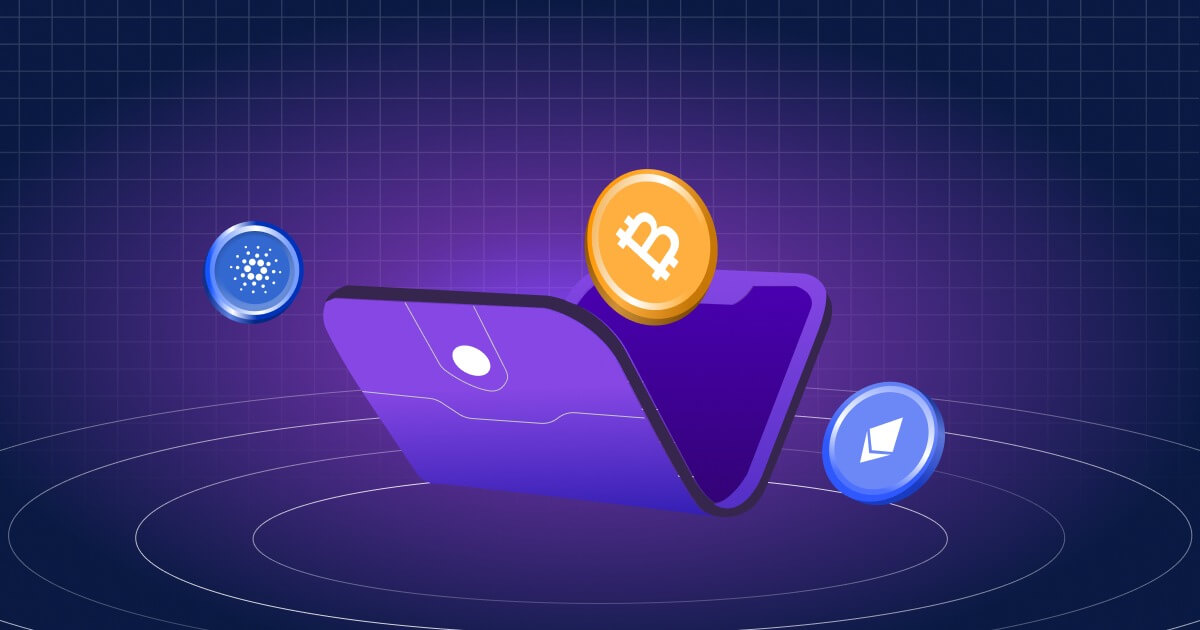Discover in this guide how cryptocurrency users may store, send, and receive cryptocurrency with the usage of crypto wallet development. The use of cryptocurrency/blockchain wallets to safeguard users’ cryptocurrency money becomes unavoidable as the number of bitcoin enthusiasts and traders rises. Because of this, companies who are passionate about crypto-fintech have begun integrating Blockchain-based cryptocurrency wallets into their operations. In essence, there are several kinds of bitcoin wallets, including hardware, web, mobile, desktop, and paper wallets. The most widely used of them are hardware wallets, web wallets, and mobile wallets. They make it easier for users to swap cryptocurrencies with other users and to store, transfer, and monitor their digital currency. Investigate the significance of cryptocurrency development on the effectiveness of businesses. Let’s now examine the fundamentals that you should think about during feature-rich cryptocurrency wallet development in this tutorial.
Understanding Cryptocurrency Wallets
A cryptocurrency wallet is essentially a software program that enables users to store, manage, and transact digital currencies securely. These wallets come in various forms, including online wallets, mobile wallets, desktop wallets, and hardware wallets. Each type has its unique characteristics and caters to different user preferences.
In addition to traditional cryptocurrency wallets, the financial landscape has evolved to include crypto banking solutions. Crypto banking platforms combine the features of a wallet with banking services, allowing users to not only store and manage their digital assets but also engage in traditional banking activities within the cryptocurrency space. These solutions often offer interest-bearing accounts, lending and borrowing services, and seamless integration with fiat currencies.
As the crypto ecosystem continues to expand, the integration of banking functionalities into cryptocurrency wallets provides users with a more comprehensive and user-friendly experience. Whether utilizing a standalone wallet or opting for crypto banking solutions, individuals can choose the platform that best aligns with their financial needs and preferences in the rapidly evolving world of digital assets.
Features Of Crypto Wallet Development
Privacy Measures
Users can access their funds without registering for KYC through a cryptocurrency wallet. Additionally, users’ private keys are transformed into 12-word mnemonic phrases (passwords) that they alone own and can use for transactions using security algorithms. It guarantees the transaction’s security and privacy as a result.
Adaptability to Several Devices
Multiple OS (operating systems) and platforms, including iOS, Android, Windows, and Linux, are supported by a cryptocurrency wallet. It offers consumers a very adaptable and safe infrastructure so they can access their cryptocurrency wallets from any location or device.
Equipped with a QR Code Reader
Crypto wallets with built-in QR code scanners allow wallet addresses (Public Keys) to be automatically scanned. With just one click, it streamlines cryptocurrency exchange.
Multi-Asset and Multi-Crypto Wallet
Ethereum, ERC20 tokens, and other cryptocurrencies should be natively supported by a crypto wallet. It needs to be able to easily integrate tokens and altcoins in accordance with company needs.
Know more about RLOS ICICI and how it enhance banking.
Integration of NFC (Near Field Communication)
The transfer of digital assets between cryptocurrency dealers is accelerated when NFC is integrated into a wallet. In order to complete the transaction, the buyer’s wallet address’s public address is immediately retrieved by the sender when they click the NFC tag on their cryptocurrency wallet.
Strong Security Measures
To create a safe infrastructure for sending, receiving, and storing different crypto assets, a crypto wallet needs to be strengthened with security measures.
Automatically Rejecting Identical Payments
To avoid chargebacks, a wallet must contain a feature that can automatically identify duplicate payments and reject them.
User Friendly Interface
A cryptocurrency wallet’s usability is improved for both novice and seasoned users when it features an intuitive user interface.
Instant Swapping
Wallet users can easily swap one cryptocurrency asset for another without the need to employ any fiat money as a middleman thanks to real-time switching features.
Development Process For A Feature-Rich Cryptocurrency Wallet
Define Objectives and Requirements
Clearly define the objectives of the cryptocurrency wallet and the specific requirements it needs to meet. Understand the target audience, the types of cryptocurrencies to support, and the desired features.
Choose the Development Platform
Decide on the platform for wallet development based on the target audience. Common platforms include web, mobile (iOS and Android), desktop (Windows, macOS, Linux), and hardware.
Select the Technology Stack
Choose the technology stack based on the selected platform. For example, if developing a mobile wallet, consider technologies such as React Native or Flutter for cross-platform compatibility.
Design the User Interface
Collaborate with UI/UX designers to create an intuitive and visually appealing user interface. Consider user feedback and industry best practices during the design phase.
Implement Core Features
Begin development by implementing core features such as multi-currency support, private key management, and user authentication. Ensure that the foundation of the wallet is secure and scalable.
Integrate Security Measures
Implement robust security measures, including encryption techniques, 2FA, biometric authentication, and secure data storage. Prioritize security throughout the development process.
Develop Transactional Features
Build features related to transactions, including QR code scanning, custom transaction fees, multi-signature functionality, and an address book. Ensure that transactions are seamless, secure, and user-friendly.
Integrate Market Information
Connect the wallet to real-time market data sources to provide users with up-to-date information on cryptocurrency prices. Implement features that allow users to track their portfolio and make informed decisions.
Offline Functionality
Implement offline functionality to ensure users can access essential features even without an internet connection. This may include viewing balances, generating QR codes, and preparing transactions offline.
Customer Support Integration
Integrate customer support features, such as live chat or a support ticket system, directly within the wallet. This enhances user experience and ensures prompt resolution of issues.
Testing and Quality Assurance
Conduct thorough testing, including unit testing, integration testing, and user acceptance testing, to identify and address any bugs or issues. Quality assurance is crucial to delivering a reliable and secure wallet.
Deployment
Deploy the cryptocurrency wallet on the chosen platform(s). Ensure a smooth and error-free deployment process to make the wallet accessible to users.
Post-Launch Support and Maintenance
Provide ongoing support and maintenance to address any issues that may arise post-launch. Regularly update the wallet with new features, security patches, and improvements based on user feedback.
Crypto Wallet Development | Security Measures
Two-Way Verification
One way to be sure that someone has permission to access the wallet is through two-factor authentication, or 2FA. Therefore, even if someone knows the password, they still need to authenticate with a second factor. To put it simply, the authentication is merely a code that is delivered to the user’s phone and that they must enter in order to access their wallet through a sign-in field.
MultiSig Wallet
A cryptocurrency wallet with a single-key address often restricts access to all funds to the owner of the accompanying private key. While maintaining a single-key address is more effective than managing a multi-sig wallet, there are security issues to be addressed. Furthermore, a single point of failure is made possible by single key access. New phishing strategies are continuously being developed by cybercriminals to exploit a single point of failure. Furthermore, medium-sized to large enterprises that deal in cryptocurrency do not choose to use a crypto wallet with a single-key address. However, multisig wallets offer a way to overcome these difficulties. With a multisig wallet, a user can only send money after receiving many signatures from specified parties.
Wallet Encryption
By using security measures like AES-256-CBC encryption and passphrase protection, the wallet’s security is further enhanced. Moreover, wallet users can prevent their money from being spent by using a passcode. Attackers are unable to take any action without the passphrase, even if they manage to obtain the device where the wallet is installed.
DDoS Attacks
Hackers utilize a sort of attack called a DDoS (Distributed Denial-of-Service). To prevent legitimate users from accessing the network or online resource, they launch DDoS attacks. They usually flood the target with bogus traffic or spread malicious requests. The target resource is completely crashed.
Phishing Attacks
Phishing attacks are the technique of hackers fooling consumers by posing as legitimate-looking emails, social media posts, or web pages. Anti-phishing software integration is therefore perfect in these situations. It prevents phishing attempts from reaching cryptocurrency wallets. It displays only the website’s actual domain name when incorporated as a toolbar into an email client or web browser. Furthermore, it stops rogue websites from impersonating trustworthy websites.
Notifications
The network admin must enable notifications for all actions and activities, including trades, logins, transactions, and updates to profile and KYC status, in order to have greater visibility, particularly in multisig wallets. It makes it possible for a wallet admin to monitor all activity and quickly identify any fraudulent activity.
Conclusion
Developing a feature-rich cryptocurrency wallet requires a meticulous approach, incorporating essential features, robust security measures, and a user-friendly design. As the cryptocurrency landscape continues to evolve, staying abreast of industry trends and user preferences is crucial for creating a wallet that meets the diverse needs of the user base. By prioritizing security, user experience, and innovation, developers can contribute to the growth and adoption of cryptocurrencies while providing users with a secure and efficient means of managing their digital assets.









